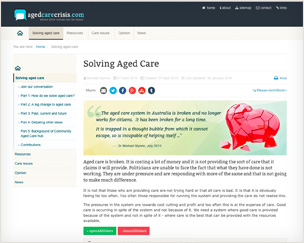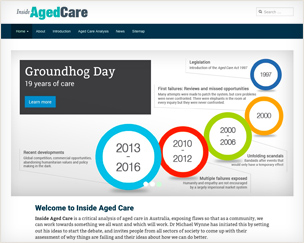Why two websites and what the hub is about
The Inside Aged Care website complements and adds to web pages I wrote for the Solving Aged Care section of the Aged Care Crisis website. The Inside Aged Care website describes the background to the proposals on the Aged Care Crisis website and also how and why a community based solution to the problems in aged care would work. It does so by examining aged care from several different points of view.
Whether you visit Solving Aged Care on the Aged Care Crisis website or read on, depends on what your interests and objectives are. This page is a brief outline of my contribution.

Aged Care Crisis: Solving Aged Care
Aged care is broken
Aged care is broken and as far as aged care is concerned, politics is broken too. Both have been failing in aged care for 19 years. They are incapable of acting effectively.
Professor Sir Michael Marmot, in the first of his Boyer lectures, argued that “health is a better measure of social progress than national income”. Its not wealth itself but the nature of society - its structure - that determine the quality of our lives and our health. We know what needs to be done but no one is looking.
So close is the link between the nature of society and health, that we can tell a great deal about how well a country meets the needs of its citizens – provides the conditions for them to lead flourishing lives – by the health status of its citizens.
Evidence shows that we need action from government – federal, state and local – from civil society, communities and families.
Source: Health inequalities and the causes of the causes Professor Sir Michael Marmot ABC Boyer Lectures: Episode 1
There are multiple problems facing the world. Our leaders don't have answers but they won't admit that to us. Our politicians have lost touch with citizens. They are locked in a thought bubble and in a world of catchphrases. They seem to be incapable of thinking outside the narrow framework which comprises this bubble.
It is civil society, citizens themselves, who will need to take control of the situation, start thinking logically and independently - and then partner with government to do something about it. Health and aged care are both part of a larger problem in society.
Our failure to address this lies in our difficulty in escaping from the past without understanding and learning its lessons. The proposed changes for aged care can be seen as part of a process of escaping the past by building on it to find a better future. It is interesting that more and more of us are talking about the same sort of path into the future.
Maddocks' proposal modified: Professor Maddocks, Senior Australian of the year in 2013 proposed a hub initiated and driven by the medical profession. Four years later nothing has happened and the profession have not stepped up to lead this process.
My proposal adopts Maddocks idea and extends it by adding proposals that I have previously made and building on them. While it welcomes participation and leadership from the medical profession my proposal is primarily community driven and controlled. It is a partnership between community and government whether federal, state or local in which citizens play a leading role and are supported by government - part of the process of taking democracy into the 21st century. It includes what Maddocks proposed but extends the proposal to meet larger objectives.
Tip: Click to expand (+) or collapse (-) content on this page
Contributing to the discussion
Both websites invite comment and ask people who have different ideas to make their contributions.
- The Solving Aged Care section of the Aged Care Crisis website focuses on proposals for the future and will only publish criticisms of the system within this section if they lead on to proposals for change. Other criticisms will go elsewhere on that site.
- The Inside Aged Care website (this website), will focus on the diagnosis of what is wrong or right about aged care. This is where we can dispute and argue about what is happening and the explanations of it.

